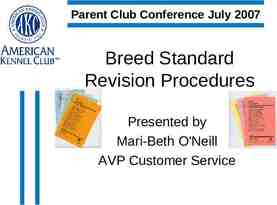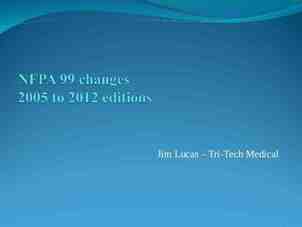Conducting Data Warehouse Assessments Joyce Bischoff Bischoff
35 Slides465.00 KB

Conducting Data Warehouse Assessments Joyce Bischoff Bischoff Consulting, Inc. Hockessin, Delaware 302-239-7202 1999, 2002, Joyce Bischoff, All rights reserved.

Agenda Definition Reasons for assessments Assessment Approach – – – – Building the Team Assembling Information Using Leading Questions Interviewing managers, users, user support, technical staff Reporting the findings – Assessment Topics Summary 1999, 2002, Joyce Bischoff, All rights reserved.

What is it? Dyn a mic to May be e ducation a e v i t a r e p o o c Needs atmosphere 1999, 2002, Joyce Bischoff, All rights reserved. ol l h c a o pr p a d e n r o u i t t c ua l a Stru v e W for D ! t s i l k c e h c a n a More th No “ri ght ” a nswe Answ rs er s d epe n u pon d p a rt i c ipants !

Data Warehouse Assessments- Why? To ensure: Business objectives are met Users are satisfied Technical staff is working effectively Corporate infrastructure is in place DW / DM processes are working effectively To ensure that tradeoffs are understood – – – – – Data currency & integrity Data availability User satisfaction Performance Flexibility 1999, 2002, Joyce Bischoff, All rights reserved.

Scheduling Assessments and Reviews ASSESSMENTS DESIGN REVIEWS Readiness Assessment Architectural Review In-Development Assessments Post-implementation Assessment 1999, 2002, Joyce Bischoff, All rights reserved. Data Warehouse Data Model Review Data Transformation & Cleansing Review Programming Review Code/Utility Review Performance Review Includes all of the above

The Approach Assess the current situation Gather information & Identify problems » » » » JAD sessions Interviews Questionnaires Documentation 1999, 2002, Joyce Bischoff, All rights reserved. Investigate Recommendations to correct problems

The Approach Executives & Managers Is the data warehouse a success? Users Technical Staff 1999, 2002, Joyce Bischoff, All rights reserved.

Building the Team Team members – – – – – Need mix of skills to examine Assessment Topics Must provide objective evaluation Need interviewing skills and technical skills Should understand best practices in the industry Makes recommendations based on best practices Each topic needs an assigned leader Team may include 2-6 people (average) What about politics? 1999, 2002, Joyce Bischoff, All rights reserved.

Assembling Information Project scope & documented requirements Business objectives of DW Organization chart, including list of data warehouse staff, key managers, and users Roles & responsibilities and how assigned Training programs for users and DW team DW architecture description, including data marts, ODS, DW, and relationships Standards, guidelines, & procedures 1999, 2002, Joyce Bischoff, All rights reserved.

Using Leading Questions Asking the right questions at the right time is the basis for successful assessments Leading questions provide a basic check list and should be prepared in advance Drill down as far as necessary to obtain needed information DW assessments require more than a checklist. . . . but a checklist helps! 1999, 2002, Joyce Bischoff, All rights reserved.

Using Leading Questions Questions: – – – – – Must be tailored for your situation Printed questionnaires; may be anonymous JAD sessions One-on-one interviews Always ask for additional comments Leading questions are only a starting point Answers point the way to identifying weaknesses and proposing improvements 1999, 2002, Joyce Bischoff, All rights reserved. ?

Assessment Topics Business Development Requirements Methodology User Satisfaction Business Value DW Strategy 1999, 2002, Joyce Bischoff, All rights reserved. Organizational Issues DW Architecture Standards & Guidelines Vendor Relationships

Assessment Topics Future Planning Metadata Strategy Performance & Capacity DW Administration Data Modeling Data Management Data Access & Delivery 1999, 2002, Joyce Bischoff, All rights reserved. Database Design

Sample Questions for Executives & Managers Is the data warehouse a success? – Business value – Return on investment – Organizational issues From your perspective, what are its strong and weak points? Did it meet strategic objectives? Which ones? Future plans for the DW or DM Are there particular persons that we should be sure to talk with (in addition to our present list)? 1999, 2002, Joyce Bischoff, All rights reserved.

Sample Questions for Technical Staff Why was the DW / DM built? Discuss the following areas with appropriate members of the technical staff: – – – – – – – – User satisfaction Discuss the process & Standards & Guidelines Metadata strategy results of the processes Data management processes for each technical area Performance and capacity planning Data access and delivery issues Data modeling & database design Future planning 1999, 2002, Joyce Bischoff, All rights reserved.

Sample Questions for Users Project starts with user requirements and will be judged against them Why was the data warehouse built? Were your special requirements considered? Business value realized? Money saved? Improved efficiency? Most important benefit realized? What is the most important question that you cannot ask? Technical staff responsive to new requirements? Level of satisfaction with DW/DM, ease of use, end-user tools, availability, etc.? Is data easy to use? 1999, 2002, Joyce Bischoff, All rights reserved.

End User Support Help Desk Adequately staffed? Types of problems encountered? Do you have problems addressing problems? Adequate support from the technical staff? Users adequately trained in data and tools? User expectations well managed? How could it be improved? 1999, 2002, Joyce Bischoff, All rights reserved.

Building the Report Summarize findings of interviews, JAD sessions, questionnaires, and analysis of documentation Cover each assessment topic that was addressed during the review Following pages summarize sample issues in each subject area 1999, 2002, Joyce Bischoff, All rights reserved.

DW Strategy What is the data warehouse strategy? Is it designed to fundamentally change the way business decisions are made? Does the strategy allow for iterative development with increasing benefits after each cycle? 1999, 2002, Joyce Bischoff, All rights reserved.

Business Value How / who sets priorities for DW development? Review procedures for evaluating ROI 1999, 2002, Joyce Bischoff, All rights reserved. Business benefits from using DW, DM, or ODS?

Business Requirements Review processes for: – Gathering requirements – Determining new requirements – Keeping requirements current – Identifying gaps between stated requirements and actual capabilities How well are current requirements met? Suggest ideas for encouraging creative use of existing data 1999, 2002, Joyce Bischoff, All rights reserved.

Organizational Issues: Leading Questions Has an “official” strategic alliance been created between the users and IT staff? Is there a high level user sponsor? Mission and objectives in line with corporate business objectives? Sufficient budget allocated? Organizational roadblocks? Who are the users? How will they be involved? How will the users be trained and supported? What are the users’ expectations? 1999, 2002, Joyce Bischoff, All rights reserved.

Organizational Issues: Leading Questions Process in place for responding to user complaints about performance, data quality, data availability, data integrity, and consistency? Does the technical staff have the skills needed to support the DW? Roles and responsibilities defined and assigned? Source data documented? What is the quality of the source data? How will technical personnel track data usage and changing user requirements? End-user tools and development tools selected? 1999, 2002, Joyce Bischoff, All rights reserved.

DW Methodology How are data warehouse projects planned? Does everyone understand definitions of DW and data warehouse technology? Effective methodology in place? – Are RAD techniques used? – All phases and activities time-boxed? – Methodology flexible enough to accommodate projects of varying sizes, ODS, DM, DW? 1999, 2002, Joyce Bischoff, All rights reserved.

DW Architecture Review use of DW, DM, ODS and their relationships Review effectiveness of current hardware / software / DW tools Scalability? How does the data flow? 1999, 2002, Joyce Bischoff, All rights reserved.

Data Management Do you track data usage? Table level? Column level? Row level? Do you track trends in growth of specific tables? How do you allocate space? How do you determine what data needs to be audited? Do you know which users use which data? Do you know which access paths are needed by various users? How do you determine this? What is your process for implementing new access paths? 1999, 2002, Joyce Bischoff, All rights reserved.

Data Management Review process of selecting source data, extraction, cleansing, and transformation Review processes for maintaining data quality Are there problems with data consistency? Identify opportunities for data integration How do you handle requests for additional data? How do you handle backup, recovery, reorganization, etc.? 1999, 2002, Joyce Bischoff, All rights reserved.

Performance & Capacity Planning How do you measure performance in the DW? Do you have service level agreements? – On what are they based? How do you measure user satisfaction with performance? How do you measure trends in performance? Comparisons of today vs. another day? This week vs. last week? How do you identify hot spots in databases? How do you identify candidates for re-partitioning? Do you have a scalable environment in terms of hardware and software? 1999, 2002, Joyce Bischoff, All rights reserved.

Metadata Strategy Review existing metadata strategy – Locations and consistency between locations – Processes for keeping it current – Accessibility to users and technical personnel 1999, 2002, Joyce Bischoff, All rights reserved.

DW Standards, Guidelines, and Procedures Review standards, guidelines, and procedures, if available – – – – – – – Requirements gathering and documentation Architecture guidelines Data and metadata Database design, development, administration Development Data quality, cleansing, transformation etc. Assess effectiveness 1999, 2002, Joyce Bischoff, All rights reserved.

Data Access & Delivery DSS EIS Ad Hoc Data Mart Traditional Data Mart Data Mining 1999, 2002, Joyce Bischoff, All rights reserved. Data Warehouse Data Mart

Data Modeling What types of data modeling are used? Are they effective? Compare with best practices Where are models stored? Are they integrated and reusable? Do users have access to data models? – Which ones? – How do they use them? 1999, 2002, Joyce Bischoff, All rights reserved.

Database Design Review processes used to design databases – – – – Usage of data models Selection of DBMS Design review processes (if applicable) Design guidelines for specific DBMSs Review database designs for selected subject areas – Multi-level data architecture? – Managed data redundancy? Compare with best practices 1999, 2002, Joyce Bischoff, All rights reserved.

DW Assessment Report Compile the results of all interviews, JAD sessions, questionnaires, reviews, and analysis of documentation Include the topic, findings, and recommendations for each area analyzed Level of detail will depend upon concerns raised by interviewees – Concerns will require deeper analysis in selected areas – Findings will depend upon the persons interviewed! 1999, 2002, Joyce Bischoff, All rights reserved.

Summary of the Process Business Value ROI Design Development Administration Organization Executives & Managers 1999, 2002, Joyce Bischoff, All rights reserved. Users Management processes Strategy Technical Staff






